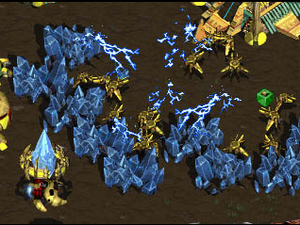
Long ago a Starcraft expert who played under the name "Zileas" wrote a famous article "The true cost of peons" - "peons" because that's what workers were called in Warcraft II. Then he updated it for Starcraft and later for Warcraft III, but unfortunately the Starcraft version no longer seems to be available. So this page attempts to summarize the basic idea.
The purpose of the tactic is blow a huge hole in the enemy's mineral gathering operation. It's effective if:
- The base you're attacking has plenty of minerals left.
- It's done at a relatively early stage, when the enemy has few bases so knocking out mineral gathering at one of them is a severe blow to their economy.
- Minerals are the most important resource. That's almost certainly true in the early game, because the lower-tech buildings and units require mainly minerals and very little vespene gas.
- It's particularly effective against the Protoss, because they are the most mineral-intensive race throughout the game. On the other hand vespene soon becomes the vital resource for the Zerg, so dropping troops on their mineral lines is less effective in the mid-game, even if they have plenty of minerals left at the base you're attacking.
The reasoning goes like this:
- If you kill N mineral-gathering workers at a base and the enemy replaces them one at a time (without diverting workers from vespene-gathering or from other bases), the loss from the Nth worker killed is the cost of building a worker plus the minerals that worker would have collected in the time it takes to build N replacement workers. In this context "loss" means minerals not available for your opponent to produce troops or buildings.
- If you work out the math, the loss of mineral production from losing e.g. 4 workers is a lot more than twice the loss from losing 2, because it takes longer to replace the 3rd and 4th workers than it does to replace the 1st and 2nd. The formula is:
loss = rN + 0.5gN(N+1)
= N(r+0.5g) + 0.5gN2
Where:
- N = number of workers killed
- r = cost of replacing each worker
- g = minerals a worker can gather in the time it takes to build a worker
The really nasty part of this formula is 0.5gN2, which means the loss increases in proportion to the square of the number of workers killed.
According to Zileas' calculations, if you can kill 5 or 6 mineral miners it's worth sacrificing all the troops and the air transport that drops them, because the minerals the enemy doesn't get while replacing the losses exceed the mineral cost of the units you sacrificed. This kind of drop is particularly effective for Protoss players who have a fully charged Templar - 2 or 3 Psionic Storms will almost certainly wipe out all of the mineral miners, and at a relatively low maximum cost (Shuttle + 1 Templar).
It's important to kill the workers as fast as possible, to maximize the damage to your opponent's economy before your troops are killed:
- With ranged units such as Marines, Hydralisks or Dragoons you should queue attacks on specific workers.
- That doesn't work with melee units such as Zerglings or Zealots, as there's a strong chance that some will not be able to get at the target because your other troops get in the way. So with melee units it's usually best to attack-move them towards the workers.
Of course the loss you inflict is temporary, as your opponent will eventually mine all the minerals if given the time. What you really gain by this tactic is time, and you must use it to expand or to follow up with a larger attack.